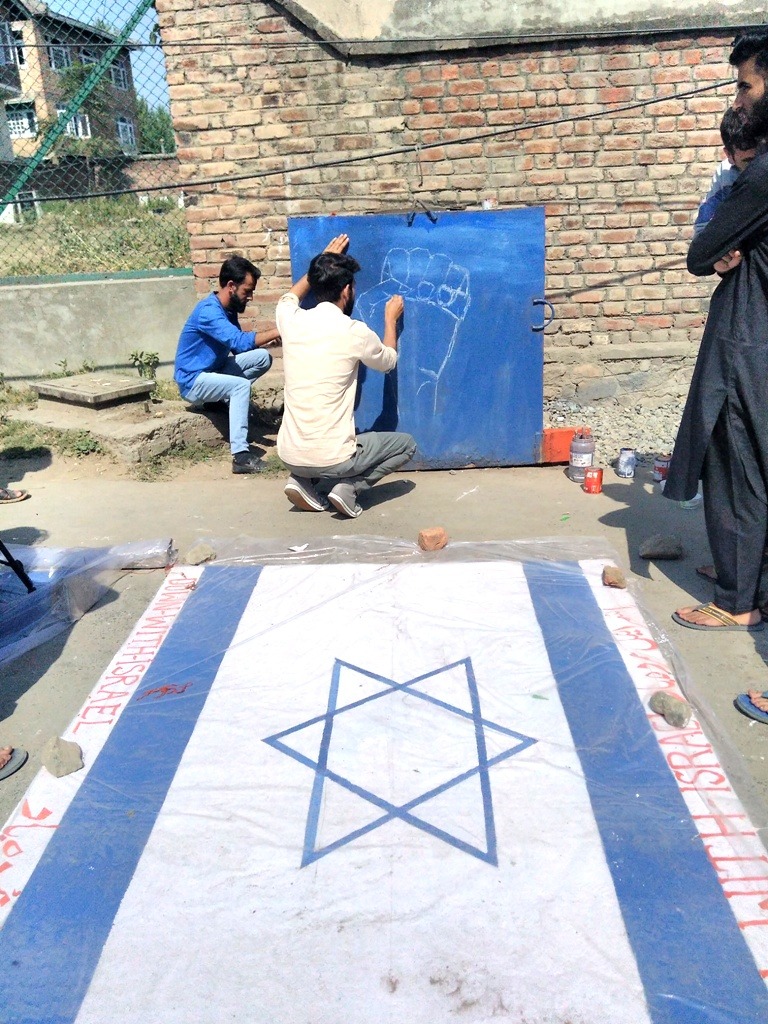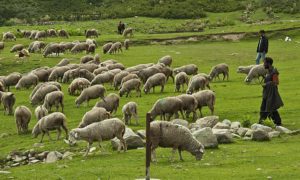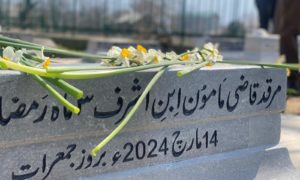The young Shia generation is as politically mature and receptive as perhaps anyone else in Kashmir. To give sense of that understanding, they lately added camaraderie to the traditional monochrome religious event, however there was a call for unity too in the fight against oppression.
When an artistic picture of the Commander Burhan Wani’s funeral surfaced in the Muharram procession at Rainawari Srinagar this year with a message—“Stop killing in Kashmir”, hardly anyone had a hunch about the changing of an otherwise traditional monochrome event into a vibrant one.
Amid fluttering of traditional black flags emblazoned with verses and quotes, the colourful banners and graffiti turned many heads around in the Shia stronghold of Hassanabad.
Behind the change however was the young ‘collective brain’ at play in one the oldest Shia localities of Kashmir, housing one of the oldest Imam Bara and hosting one of the largest Muharram gatherings on 7th of Muharram.
Those flex banners and graffiti art carried messages of dissent, protest and unity amongst Muslims. The youngsters who volunteered for the change had taken a cue from the Western popular phenomenon called the DIY (Do It Yourself) Method. “We wanted to take a positive initiative and build things all on their own,” says a young volunteer.
These banners and graffiti appeared right at the locality’s gateway. A large Israeli flag painted on the street reflected a strong protest against the Zionist state. Adjacent to this flag was a banner carrying a protest against the innocent killing of Muslims in Burma.

FPK Photo/Ali Saffudin
“We did everything on our own,” says Waseem, a proud volunteer. “From the initial stages of fund raising to selecting the messages to getting them printed and placing them at significant places all around our Rainawari.” The young lots were able to gather around Rs 40,000 with the support of their elders.
They had raised a banner stressing on Shia-Sunni unity, too.
“Muslims are brothers,” read a banner, “and will not be segregated by the pseudo-propaganda sponsored by corrupt elements.” One such banner was placed right outside a local Sunni Masjid.
“We did that to assert that we collectively feel the importance of unity and work towards that goal as one unified family,” says another volunteer.
A few students of Fine Arts were also invited to add more art and attitude to the graffiti. They made some beautiful and politically strong graffiti on an old abandoned oil tanker highlighting the issues of all the oppressed states of the world, including Middle East, Burma and Kashmir.
“These Muharram processions have two aspects,” believes Syed Shahriyar, a prominent photojournalist of Kashmir living in Hassanabad. “One is to mourn on the tragedies of Karbala and remember them and second is the political context of these processions.” Through these processions, Shahriyar says, the Shia community empathises with all the oppressed communities of the world by standing up against the oppressors.
Each year in the month of Muharram, the followers of Imam Hussain (AS) remember the sacrifices and tragedies which He and his companions went through during The Battle of Karbala on Muharram 10, in the year 61 AH of the Islamic calendar (October 10, 680 AD) in Karbala, in present-day Iraq.

FPK Photo/Ali Saffudin
The battle of Karbala has sparked a religious, cultural and ideological phenomenon across the globe over the period of its occurrence. It has also constantly remained relevant and impactful towards the contemporary times by denouncing the tyrants of the past and protesting against the oppressors of the present.
The arrival of the month of Muharram sends fervour across the followers of Imam Hussain (AS) — as they completely immerse in the commemoration of the martyrs of Karbala. From the first ten days of Muharram, big processions are taken out to commemorate the martyrs to the 40th day from Ashura (10th Muharram), which marks the largest Shia pilgrimage known as Arbeen in Karbala (Iraq). All this clearly depicts that Muharram commemoration is a global act.
Though the followers of Imam Hussain in Kashmir leave no stone unturned to display their love for the martyrs of Karbala, but this year, the youngsters of Hassanabad tried to add a new dimension to it.

FPK Photo/Ali Saffudin
Raising colourful banners was done to attract people’s attention, says Saajid Ali, a young medical representative from Hassanabad and a volunteer. “We specifically used quotes addressing the contemporary issues through them.”
What youngsters from Hassanabad did this year is seen as the progressive sign of infusing a Leftist and politically charged approach with the traditional and cultural manner of carrying out Muharram processions.
“But it was all done with an intention to show allegiance to the ideology of Imam Hussain [AS],” Ali says, “which stands for humanity and justice and tells us to be proactive against oppression and tyranny.”








